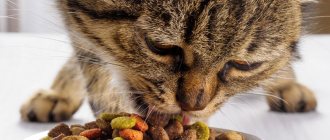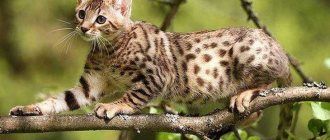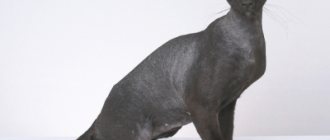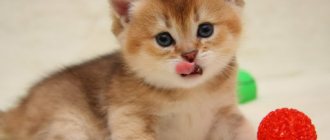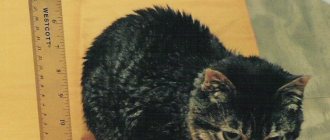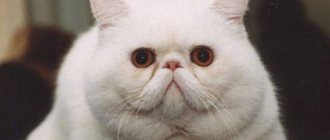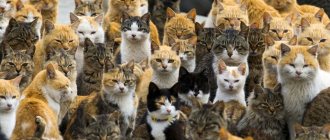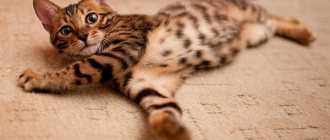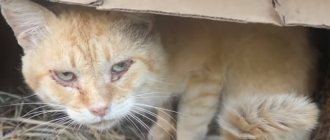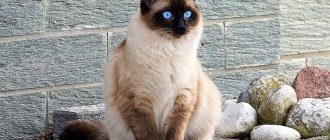A miniature creature with short legs, huge round eyes and a funny face that evokes only tenderness - this is what a Napoleon cat looks like. Although it appeared not so long ago, it has already gained and continues to gain popularity among cat lovers, including in Russia. For those who were not yet familiar with this cat breed, it will be useful to read this article and learn everything about it, starting with history.
History of the breed
For the appearance of the Napoleon breed in 1955, we should thank Joe Smith, an American breeder, but initially not of cats, but of Basset Hound dogs. He dreamed of creating unusual cats with an appearance combining features of munchkins and Persians. The initial attempts turned out to be failures, the kittens were born with pathologies, and all because, according to some parameters, the genotype of Persian cats was not suitable for crossing.
The breeder did not give up, delved into research and finally managed to breed several normal, mutation-free kittens. Subsequently, Joe Smith quit crossbreeding and castrated all the remaining animals. Ten years passed, and other breeders continued Smith's work, as a result of which Napoleon cats became one of the rarest and most unusual in the world. This breed has also received official recognition from TICA (International Felinological Association).
Features of breeding, choice of kitten and price
Napoleons belong to the category of rare and relatively expensive breeds. The reason lies not only in exclusivity, but also in the difficulty of breeding. Crossing Munchkins and Persians in most cases leads to the birth of kittens with various defects. The culprits for this are the capricious genes of Persian cats. To get excellent offspring you need not just to select beautiful animals, you need to understand pedigrees, blood connections and genetics.
Getting healthy offspring that meets all standards is not an easy task and can only be achieved by experienced breeders.
The TICA standard allows for a variety of matings within several breeds: Napoleon - Persian cat (including Himalayan and exotic shorthair) - Munchkin.
Photo of a cat of the Napoleon breed
Description of the breed
Externally, dwarf cats are very similar to a miniature short cat, but still differ from it in many ways. And the main most noticeable difference is the size of the animal. Persians, as a rule, are large cats, and female Napoleons reach a maximum of 2 kg in weight, while males are only half a kilogram or a kilogram heavier. The compact size of Napoleons captivates the hearts of many cat lovers. After all, adult cats grow only to the size of a six-month-old kitten of a small breed.
From the Persians, Napoleon inherited a squat build and a powerful backbone. The body is elongated, the hips and shoulders are powerful, the legs are low, and the tail is fluffy and long.
The shape of the head also has its own characteristics. The face, which always has a slightly surprised look, is flattened and round with round huge eyes and a short nose. As you know, Persians often have breathing problems. And Napoleon has such problems
no, and this is due to the structure of their nose: it is almost straight.
There are no strict requirements for the length of the coat of representatives of this breed. You can find among them both long-haired cats with fur that almost completely hides their paws, and short-haired cats that are plush to the touch. According to the standards, any colors of Napoleons are acceptable, even point and one-color.
There are two types of Napoleon cats:
- The classic Napoleon looks like an ordinary cat with long legs;
- The dwarf Napoleon is distinguished by its miniature and elongated body and short legs. Dwarf cats are also called Napoleon extreme and because of their original appearance, these kittens are much more expensive than representatives of the classic species.
Coat and color of Napoleon Minuet
Various photos of Napoleon Minuet cats confirm the fact that this breed does not have specific requirements for coat color. These can be either solid-colored cats or colorpoint cats.
Read here Persian cat: life expectancy, character, care and detailed description of the breed (90 photos)
Regarding coat length, there are also no specific requirements established by breed description standards. Therefore, there are both short-haired and long-haired Napoleon Minuettes.
Character of Napoleons
The friendliness of Napoleon cats knows no bounds. They are very trusting and gentle animals, devoid of aggression. These cats love people very much and are ready to go into the arms of any of them they see. Cats of this breed get used to a new home and owner extremely easily. They need constant love and attention, so they always stay close to their owner and will not miss an opportunity to climb onto his lap once again.
It is believed that the cats were named Napoleons after the French
Emperor Napoleon Bonaparte. Looking at them, you can actually find the traits of their high-ranking namesake. Cats walk with a proud and majestic look and are in no hurry. And their face is like a kitten’s – a little surprised and curious. Regardless of age, these animals are always equally inquisitive and playful. Their height allows them to jump wherever they want.
The Napoleons have one drawback - their excessive trust in people. They can easily approach anyone, even a stranger, and once they fall into their hands, they will allow them to do whatever they want with them. That is why it is better not to let them go out alone.
Character
Since the Napoleon breed is still very young, there are not many representatives of the species. It is difficult to trace patterns of character, but we can take the temperament of Minuet’s parents as an example.
Persian cats are extremely affectionate towards their owners. Therefore, Napoleon will most likely also follow on your heels. The cat will also sleep on you.
Munchkin is inquisitive. The runt will be able to climb anywhere his tiny paws can reach. Napoleon will also try to scout out the situation in every corner.
Owners of the rare Napoleon breed report that these cats are quite intelligent. Commands and rules in the house are learned quickly.
When keeping a Napoleon, it is important to understand that short legs will not always allow the cat to hide from children or pets, so you need to keep an eye on such a pet.
Otherwise, miniature size does not interfere with the cat’s life at all: he is active, playful and inquisitive.
Care and maintenance of Napoleons
These cats can be considered unpretentious and one of the most flexible, but they still require care and constant care from the first months of the baby’s life. As a rule, they get used to the toilet quite quickly. The fur will have to be taken care of especially carefully. Short-haired representatives of the breed will need to be combed once or twice a week, and long-haired representatives much more often, preferably daily. It is recommended to wipe the ears and eyes once a week. No care is required for the claws; you just need to purchase a scratching post.
And knowing the information about its parents will allow you to choose the best option for caring for your pet.
Nutrition
The nutrition of Napoleons requires special attention. Their appetite, of course, is excellent, and they can eat whatever is given to them, but it is still best to give preference to food in their diet
super premium class and be sure to add vitamins.
The pet owner is required to constantly monitor its weight. Since these cats can often eat more than they should, this can have a detrimental effect on them and lead to obesity.
Sometimes it is recommended to give Napoleons a paste that will dissolve the fur accumulated in the stomach.
Who is suitable for Napoleon cats?
Napoleons, despite their mobility, are very patient with children and allow them to carry them in their arms, squeeze them and dress them up like a doll. They do not use claws for self-defense; they need them to climb trees.
Therefore, families with children can safely get a cat of this breed. But it’s still better to tell young family members in advance how to properly handle a pet. This will allow your furry pet to avoid a feeling of discomfort, because if a child handles Napoleon carelessly, he will not be able to fight back due to his excessive good nature.
Diseases of the breed
The average lifespan of these charming creatures
ranges from 10 to 12 years, but they cannot boast of excellent health; on the contrary, representatives of this breed often get sick and their health is poor. Because of their short legs, such pets get tired quickly, which is why they have a sedentary lifestyle.
They also have an increased load on the spine, the body is longer in proportion to their height, and the spine may sag.
Often, a pet can get injured trying to jump somewhere or, even worse, jump from a height.
In addition, these cats are more likely than others to suffer from kidney failure.
Where to buy kittens and what to look for when choosing them
Until recently, buying a Napoleon kitten in Russia was very problematic, even almost impossible. But today it has become much easier to do this, because both experienced felinologists and ordinary breeders of dwarf cats are engaged in breeding this breed. The cost of kittens, due to the fact that this breed is quite rare, varies from 35 thousand to 75.
When buying a pet, you should give preference to international
or to Russian nurseries that specialize in selling dwarf cats. When purchasing a kitten from private breeders based on an advertisement, you should be careful and make sure that everything will be without deception by checking the necessary documents.
When buying a dwarf cat kitten, first of all you need to check whether its external characteristics meet the established standards. The good health of the animal is evidenced by its activity, the presence of a clear cornea and shiny, shimmering fur, as well as nail plates without peeling.
It is also recommended to stay with your future pet for some time in order to get to know him better and learn about his character traits and intellectual abilities.
Acquisition
It's not easy to purchase. Since at the moment there are only nurseries in Russia in Moscow and Voronezh.
In addition, many people have a question: how much does the Napoleon cat cost? The answer, unfortunately, will not be liked by many, since it is quite high and ranges from 30 to 90 thousand rubles.
Reviews from Napoleon owners
You can leave your reviews about the Napoleon cat breed, other users will be interested:
Julia
Our family has two small children. They dreamed of a kitten for a long time and asked us to buy one for them. My husband and I started reading about different cat breeds on the Internet until we saw a short-legged Napoleon cat. Fell in love with her at first sight! We found a cattery and a kitten we liked. The price is, however, high, but this charmer is worth it. He's just like a toy, our fluffy little ball. Children also adore him, play with him, even carry him in a doll stroller. And the kitten seems to like it all, he didn’t even scratch anyone even once. This is our ideal pet!
Vasilisa
I saw Napoleon's cat from my friends. She is so pretty that you won’t be able to look at her indifferently no matter how hard you try. I began to ask them more about this breed, their character, how to care for them, what to feed them. Just at that time I was looking for a pet for myself. I learned that these cats require the constant presence of the owner nearby. This suits me because I work on my home computer. I bought myself a four-month-old baby girl. And now I can’t be happier with her and can’t imagine how I lived without her.
Pauline
I am the owner of a two-year-old dwarf cat and I can only say the best about him. He is very kind, does not bite or scratch. He loves to be held, even if strangers come into the house, he easily finds contact with them. He is my beloved joy and happiness!
Interesting video about Napoleon cats:
Napoleon cats are very small in size. That is why they are so highly valued, because miniature pets evoke delight and affection. The breed requires special care, as during the selection process some problems arose with the genes of the animals.
How to choose a kitten
A Napoleon kitten is not a cheap pleasure. The average cost is approximately 50 thousand rubles. Buying a pet should be approached with all responsibility.
Firstly, it is better to refuse to buy from hand. Of course, the cost of such a kitten is much lower. But there is no guarantee that instead of a true Napoleon, a cat obtained as a result of crossing other breeds (not Persians and Munchkins) will not be sold. Secondly, cooperation with an unverified breeder increases the risk of buying an animal with a whole bunch of hereditary diseases.
In Russia there are not many nurseries engaged in breeding Napoleons yet. Therefore, some decide to buy a cat abroad. On the one hand, foreign breeders have much more experience in breeding. On the other hand, the chance of being deceived is very high. There are times when future owners receive an ordinary cat instead of a purebred kitten or just an empty box.
When going to the nursery, you definitely need to pay attention to the baby’s behavior:
- activity;
- curiosity;
- goodwill.
These are the traits that should be dominant in a kitten’s behavior. Aggression or cowardice are not inherent in Napoleon cats.
Particular attention should be paid to appearance. Clean ears and eyes, straight paws and tail, shiny soft fur indicate good living conditions and health. It is necessary to study the pedigree and also see the kittens’ parents. This will help to understand whether the future pet has a tendency to hereditary diseases.
History of the origin of the breed
These cats are named after the famous French commander Napoleon Bonaparte. At the same time, historians unanimously claim that during his lifetime Napoleon not only hated furry creatures, but even suffered from gatophobia (fear of cats).
Some owners jokingly dress their pets in the costume of a famous commander
Napoleons appeared quite recently - at the end of 1997. The breed was first bred in the USA by breeder Joe Smith. The breeder wanted to get cats whose appearance would combine the best qualities of fluffy Persians and short-legged munchkins. All of Smith's previous attempts led to failure: the offspring of Persians and Munchkins had serious defects and were not suitable for further breeding.
Only after painstaking work on the parents and DNA research did Joe Smith manage to obtain several specimens of the new breed. The kittens were born without any congenital diseases or gene mutations. But the breeder decided to stop his experiments and castrated all the males of the breed. The difficult decision was not easy - felinological organizations refused to register the new breed, Smith spent his last money on bureaucratic delays.
Subsequently, only females remaining after the experiments of the American breeder were used for breeding by other breeders. During the crossing, short-haired exotics were also involved in mating. As a result, the Napoleons acquired a very unusual appearance. In 2021, the breed was recognized by the American felinological organization TICA, and a little later by the Russian ASSOLUX.
The animal resembles a plush toy
The Napoleon cat breed is one of the “youngest” in the world. In this regard, there are not many representatives of Napoleons yet, and the largest breeders are located in the USA.
In 2015, cats of the Napoleon breed received another name - Minuet Cat. However, the new name has not yet become widespread.
About the breed
The breed that bears the name of the great emperor actually has nothing in common with him. Firstly, it appeared relatively recently. Just in 1995. Secondly, Napoleon himself was afraid of cats like fire.
An American breeder began work on breeding miniature pets that combine the characteristics of Persians and Munchkins. The first attempts did not give positive results. Very often kittens were born with serious defects and genetic abnormalities. As a result, Joe Smith despaired of achieving his goal.
Only after some time did he manage to get the first kittens with soft and fluffy fur, short legs and the characteristic flattened face of the Persians. But, for unknown reasons, the breeder ceased its activities and sterilized all offspring.
His followers managed to breed a new breed almost 10 years later. The Napoleon breed is now recognized by TICA. It is considered very rare and expensive. This is due to great difficulties in obtaining offspring. It is very important that cats are born not only beautiful, but also healthy.
Appearance of Napoleon cats
Since the Napoleons had Persian cats and munchkins in their family, the appearance of the new breed combines the characteristics of their ancestors. The main features of an adult Napoleon are the following:
- small height - up to 20 centimeters at the withers;
- weight from 2 to 3.5 kg (males are slightly larger than females);
- rounded head shape with a powerful lower jaw;
- slightly flattened muzzle;
- short ears with sharp tips;
- long body;
- wide back and powerful neck;
- the front legs are shorter than the hind legs;
- round eye shape.
According to the official standard, fur colors can be very diverse. Often the breed combines several shades of the same range (for example, white, gray and peach).
Modern Napoleons are considered shorthaired cats, although in fact there can be three different subspecies:
- long-haired - with very developed guard hair and undercoat fluff;
- semi-longhaired - short coat length;
- short-haired (plush) - upright down and very short guard hair.
Due to their flattened muzzle and small size, adult Napoleons resemble kittens. Thanks to competent selection, it was practically possible to eliminate breathing problems due to brachycephaly, which is observed in almost all Persians. Napoleons by TICA standards can only have a straight nose with a slight notch. It is important that Napoleons do not suffer from increased tear production.
Disqualifying characteristics of the breed include the aggressive nature of the animal, long paws, a curved tail, skeletal defects, cryptorchidism, polydactyly and other defects characteristic of any breed. Accordingly, a cat that has at least one of these disqualifying characteristics cannot be allowed for breeding or participation in exhibitions.
Video: breed overview
Appearance and standards
The doll's face and low-slung body allowed the minuet to win many hearts. Meanwhile, a miniature appearance is not a hindrance to a strong physique. Napoleons have strong, broad bones and well-developed muscles, which allow cats to remain active until old age. If we describe the appearance of a minuet, the word “round” would be most appropriate.
Muzzle
The muzzle is round, wide and moderately short with well-defined whisker pads. The ears are medium in size with rounded tips and set wide apart. The eyes are also large and round, very wide open, but not protruding, set moderately deep. The color of the iris matches the coat color. The nose is short and wide, not snub.
Body type
The body is elongated, strong, rounded in all outlines. The neck is moderately short. The topline is straight. The back is flat and wide. The legs are short or long depending on the type, always strong and stable. The tail should be proportional to the body, not short.
Coat and colors
Based on the length and structure of the coat, there are three types of cats in the breed:
- Long-haired - well-developed undercoat and long guard hair. The coat is light, smooth and shiny.
- Semi-longhaired cats are cats with developed down and dense guard hair. The type of coat is the same as that of the Persian group of breeds.
- Plush - thanks to the thick down, the short guard hair stands almost vertically, forming the so-called plush coat.
Absolutely any colors are allowed without restrictions, including Siamese.
Varieties of Napoleons
There are two types of cats in the Napoleon Minuet breed:
- Classic - animals with standard, long paws that are not of particular value in the breeding and exhibition sense. While there is the possibility of interbreeding, they are practically not used in breeding;
- Extreme - short-legged cats are 2 times smaller than ordinary cats.
Regardless of paw length, all Napoleons are dwarf. The weight of adult males does not exceed 3 kg, and females – 2 kg.
Character and behavioral characteristics
Napoleons have a cute, childish expression that lasts throughout their lives. This is why the breed is so popular in families with children: kids simply love to play and pet pets that look like toys. In addition, cats are easily trained in the basic commands “can” and “can’t”, the tray and the place of eating. Animals are very smart, so there will be no problems raising a small kitten.
Napoleons jump very funny. They do it differently from other cats: the awkwardness of the jump is associated with a long body and shortened legs.
Relationship with the owner
Napoleons cannot stand being alone. It is important for them to be the center of attention and always feel the presence of people nearby. The cat quickly becomes attached to its owner, but allows itself to be petted by guests.
Pets have a very affectionate character. The best way for a cat to spend time is to purr on its owner's lap. Sometimes Napoleons can even seem intrusive in their requests for affection and attention.
The breed is friendly and peaceful: therefore, small children can play with animals without fear of getting scratched.
Behavior with other animals
The affectionate, sociable nature of Napoleon cats allows them to coexist peacefully with other pets. They are not prone to aggression, so they easily make contact with other cats, dogs and even small rodents. Therefore, lovers of a wide variety of pets can safely get a Napoleon, since the pet will definitely find a common language with other animals.
Positive and negative qualities of cats
For all their external beauty and affection, Napoleons have one significant drawback - gullibility. A cat will easily jump into the hands of a stranger. Therefore, Napoleon should not be allowed to walk alone, even in the closed courtyard of a private house.
Representatives of the breed are not cheap, so the loss of a pet is not only the loss of a friend, but also a significant capital.
Table: qualities of Napoleons
| Positive traits | Negative qualities |
| Friendliness | Excessive gullibility |
| Affectionate and peaceful disposition | Impudence in begging for affection |
| Get along with people and animals | |
| Cute childish appearance |
Character and education of the Napoleon breed
The Napoleon cat is a very trusting animal, which makes a very strong impression with its complete lack of aggression, affection and gentleness. Napoleon kittens need care and love, but they themselves are ready to give love to everyone. They show amazing patience with children's pranks and allow them to play with them in almost any way: put them in a stroller, swaddle them and cuddle them. They get used to new people and places very quickly, and like dogs they remain loyal to their owner until the end of their lives.
Napoleons are one of the most peaceful and charming cats.
Pet health and life expectancy
When developing the breed, special attention was paid to ensuring that the cats did not have any genetic mutations and a predisposition to typical feline diseases. Therefore, Napoleons are not prone to the vast majority of diseases - of course, with proper care.
Breeders assure that the health of each individual depends entirely on the pedigree. Therefore, if there are no sick animals among the kitten’s relatives, then we can safely talk about its good health.
Some representatives of the breed are prone to polycystic kidney disease. Napoleons inherited this disease from Persian cats, which often experience kidney problems. However, as mentioned above, if there was no polycystic disease in the family, then with a high degree of probability we can talk about the normal health of the pet.
The lifespan of Napoleons is 10–12 years. For ordinary cats this is a normal period, although Napoleons cannot be called long-livers.
Due to genetic abnormalities, representatives of the breed may suffer from kidney disease
Breed health
It was important that the new breed did not inherit genetic mutations and diseases characteristic of the cat world. As a result, if a cat is properly cared for, it will enjoy its health. Pedigree plays an important role here.
It's never perfect anyway. There are individuals with a tendency to polycystic kidney disease.
Unless the owner is a professional breeder, the animals must be spayed or neutered. Vaccination always follows a plan approved by a veterinarian.


